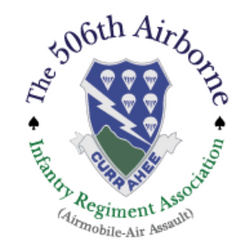Currahees Uncover Enemy Arms Cache
July 30, 2014 at 5:51 PM
Transcribed article from The Screaming Eagle weekly Army newspaper
Vol. 1, No. 37 -- 101st Airborne Division -- December 9, 1968 -- page 8
CAMP EAGLE -- An alert point man led 3rd Brigade Paratroopers to a large weapons cache in an enemy base camp southwest of here recently.
Six days of reconnaissance in-force missions by B Co., 1st Bn., 506th Abn. Inf. in rain soaked triple canopy jungle had failed to detect enemy activity.
But as the company moved through sodden semi darkness two and one half miles from towering Nui Ke Mountain, the point element discovered an observation post, used recently by the enemy as an early warning system. It was unoccupied.
Company commander Capt. Michael J. Metzger, San Jose, Calif., alerted his troopers and spread them out as much as the thick jungle would permit. Then they moved out.
"I was on point and saw a small trail leading off into the jungle," said Sgt. Thomas W. Andrews, Harbor Springs, Mich. "We moved down until we hit a deep valley next to a river. There, I spotted a hooch stuck up in the underbrush."
The find was relayed to platoon leader Lt. Herman A. Theeke, Plymouth, Mich., who notified Metzger.
The youthful captain set up one platoon as security and gave his other three platoons word to search the entire area.
Spec. 4 Carl Clark, Alexandria, Va., radio telephone operator, suddenly found himself the busiest Paratrooper in the area.
"Everyone was trying to talk at once," he said. "Everybody was finding something somewhere. Each time I would tell the CO that more weapons or hooches had been found, there would be another call."
Andrews, pulling point for the 4th platoon, entered one of 21 hooches that were found and carefully looked inside a reinforced bunker under the floor. As his eyes adjusted to the darkness, he made out a pile of dirt.
"I started to dig and hit metal," Andrews said. "More and more rifles popped up. There were 28 SKS rifles under that dirt."
Another group found two 75 mm. recoilless rifles, complete with tripods and sights.
As darkness fell and more discoveries were made, Metzger received instructions to remain with the cache until it could be moved. He began setting up his night defensive position around the base camp.
Spec. 4 Ralph R. Byers, Mars, Pa., and two other soldiers were moving to an observation point outside the perimeter when they found another hut.
"It was really getting dark, but we peeked in and saw two 60mm. mortars, one 82 mm. mortar, and an SKS rifle," Byers said. "We notified the platoon leader, then moved out."
Only the splatter of raindrops interrupted the quiet of the night. As light filtered down through the 100 foot high cover, the search was resumed.
The Paratroopers found buildings obviously used as mess halls and others that were hospitals and aid stations. They discovered more ammunition.
Finally, came the hardest job of all--cutting a landing zone so the cache could be lifted out.
As the last of the helicopters lifted out the two M 1 carbines, two RPD machine guns, two 12.7 mm. heavy machine guns, one 60 mm. mortar tube and sight, nine 75 mm. rounds, 21 RPG rounds, 54 RPG 7 rounds, three hundred .50 cal. rounds, fifteen 82 mm. rounds, and twenty-four 2 1/2 pound blocks of C3 explosives, the weary looking captain watched smiling.
"All that and we never fired a shot," he said. "This has to hurt Charlie bad."
Tags:
